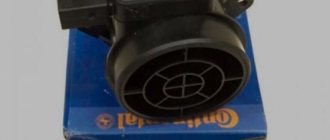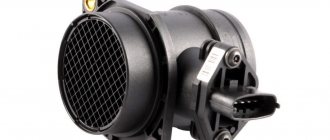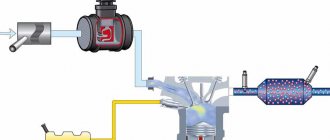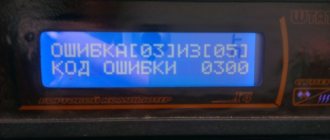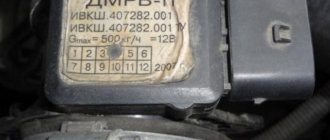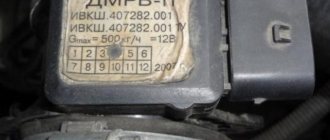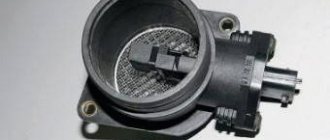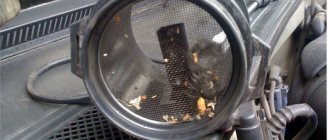When controlling the operation of a car engine, the electronic unit acts according to the readings of a group of main sensors. These include a meter for the amount of air sucked into the intake manifold through an open throttle valve. Receiving this data, the controller increases or decreases the fuel supply, achieving the optimal ratio of the components of the combustible mixture. Failure of the flow meter significantly impairs the performance of the power unit to the point of making it impossible to move further. Therefore, it is advisable for novice drivers to study the signs of a malfunction of the mass air flow sensor (abbreviated as MAF).
Flowmeter design
Knowing the design of the air sensor, you will quickly understand the principle of its operation and understand why a faulty meter cannot be repaired, but only replaced. The device is not difficult to find - it is built into the air duct connecting the filter - air flow purifier with the throttle valve block. The exact location depends on the make and model of the car.
The majority of vehicles in use are equipped with hot-wire or film meters. The difference is in the design of the sensing element; the operating principle remains unchanged. An anemometer flow meter is a housing in which 2 platinum threads are placed - a measuring and a reference. How does the mass air flow sensor function in a car:
- The controller supplies power to both threads. As they heat up, they change resistance equally.
- When the engine is running, the first thread is washed by air passing through the throttle and cooled. The stronger the air flow, the more intense the cooling.
- The electronic unit records the difference in resistance between the measuring and reference threads. Having made the calculation, the ECU determines the mass of passing air and directs the corresponding amount of fuel to the injectors.
Reference. In modern cars with turbocharged engines, mass flow sensors are replaced by absolute pressure meters (MAP) - more reliable devices with a long service life. Manufacturers began to equip new naturally aspirated engines with similar products.
The film measuring device operates on the same principle, only instead of threads, platinum-coated ceramic elements are used. That is why it is quite possible to check the mass air flow sensor, but not to repair it. A burnt thread or damaged coating cannot be replaced, only the entire product.
“Features of replacing the regulator on Kalinas and Grants”
A specialist will tell you what needs to be taken into account when replacing the regulator in domestic cars and what mistakes should not be made (the author of the video is the channel In Sandro’s Garage).
In the electronic engine control system of the popular Russian small car Lada Kalina, the sensor responsible for the mass flow of intake air (mass air flow sensor) is a very important component. It is located close to the air filter. Its purpose is to determine the mass fraction of air flow supplied to the combustion chambers of the engine.
If incorrect operation of the mass air flow sensor is observed, this creates the preconditions for malfunctions in the functionality of the engine. Diagnostics will help identify the problem. If a breakdown occurs, the owner will need to replace the specified sensor.
It is no secret that any component of the Lada Kalina car needs a periodic review of its condition. Prevention allows you to timely identify a malfunction and take prompt measures to eliminate it. Next, we will tell you how to check the mass air flow sensor.
Consequences of sensor failure
When, for various reasons, the sensor fails or produces incorrect readings, the controller changes the operating algorithm. He begins to prepare the air-fuel mixture, focusing on the throttle position meter and lambda probe. Due to the lack of data previously received from the mass air flow sensor, the electronic unit “does not know” about the real amount of incoming air and cannot mix it with gasoline in optimal proportions.
By switching the controller to emergency operation mode, you can determine the main symptoms of a malfunction of the mass air flow sensor:
- on the driver’s dashboard, the control unit turns on the Check Engine light display, indicating problems in the fuel supply or ignition system;
- idle speed is unstable - it either rises to 1500 rpm, then drops to zero (the engine stalls);
- “When cold” the engine starts with great difficulty;
- incorrect preparation of the combustible mixture causes an increase in fuel consumption, regardless of driving conditions and operating mode;
- There is a decrease in the power of the power unit and frequent unreasonable jerks while driving.
Note. The inclusion of the Check Engine indicator does not provide the driver with specific information about the nature of the breakdown. The inscription calls for diagnosing engine systems using a computer connected to the service port. In this way, you can check the performance of the mass air flow sensor and other sensors in a service station.
Indirectly, a malfunction of the flow meter is indicated by the appearance of black smoke from the exhaust pipe. If the vehicle does not have an on-board computer and it is impossible to track instantaneous gasoline consumption, it is worth unscrewing 1-2 spark plugs from any cylinders and inspecting the electrodes. A layer of black soot will confirm excessive enrichment of the mixture due to emergency operation of the electronics.
WHERE IS THE DMRV?
The sensor is located between the air filter and the air supply hose (pictured No. 13).
DFID part numbers on LADA vehicles:
- Lada Priora, Kalina and Niva 4x4 - 21083-1130010-20.
- Lada Granta and Kalina 2 - 11180-1130010-00.
- Lada Vesta, Largus and XRAY - no mass air flow sensor. On modern VAZ (21127, 21129, 21179) and Renault (K7M and K4M) engines there is no mass air flow sensor; Instead, an absolute pressure sensor (MAP) and an air temperature sensor (DTV) are installed.
Causes of problems
The air flow meter becomes unusable for the following reasons:
- a lot of dust and dirt gets on the measuring elements, because the car owner rarely changes the air filter;
- on heavily worn engines, gasoline and oil vapors penetrate into the mass air flow sensor through the crankcase ventilation pipe;
- a hole in the corrugated air duct from where dust is sucked in;
- accidental damage due to unqualified repairs;
- break in the wires connecting the sensor connector to the controller.
In addition to the above reasons, natural wear and tear of the device also occurs. The service life of a new mass air flow sensor is 50–250 thousand km, depending on the make and origin of the car.
Where is the DMRV located?
The sensor is located between the air filter and the air supply hose (pictured No. 13).
DFID part numbers on LADA vehicles:
- Lada Priora, Kalina and Niva 4x4 - 21083-1130010-20.
- Lada Granta and Kalina 2 - 11180-1130010-00.
- Lada Vesta, Largus and XRAY - no mass air flow sensor. On modern VAZ (21127, 21129, 21179) and Renault (K7M and K4M) engines there is no mass air flow sensor; Instead, an absolute pressure sensor (MAP) and an air temperature sensor (DTV) are installed.
Diagnostics in garage conditions
The above symptoms also appear during other failures, for example, failure of the oxygen sensor or throttle position. In all such cases, the electronic unit operates in the same way - it goes into emergency mode for preparing the air-gasoline mixture. Hence similar consequences.
To test the mass air flow sensor without instruments, follow these simple steps:
- Open the hood and disconnect the connector from the mass air flow sensor.
- Start the engine and monitor idle speed. The controller must raise the crankshaft speed to 1500 rpm and hold it stably. If the idle speed continues to float, the flow meter is most likely working.
- Make a test drive over a short distance, observing the behavior of the car. If the engine starts to work even worse, then the problem lies elsewhere.
This technique does not allow one to accurately determine the “culprit” of problems, especially when there are several of them. For example, at the same time the lambda probe failed. It is necessary to carry out more accurate diagnostics - check the mass air flow sensor with a multimeter according to the following instructions:
- Switch the multimeter to voltage measurement mode. Open the hood and find the sensor connection block.
- Connect the red wire from the device to the input signal contact (usually colored yellow). Connect the second clamp with black insulation to the green conductor.
- Turn on the ignition and record the voltmeter readings.
A voltage in the range of 1–1.03 V indicates full functionality of the sensor.
If you observe signs of emergency mode while driving a car, it is worth checking other meters that affect fuel supply. Readings of 1.04–1.05 volts indicate that the platinum elements of the sensor are quite worn out, and you should prepare to replace the mass air flow sensor. A value of 1.06 V or more indicates that the air flow meter has died. You need to purchase a new meter and install it on the air duct instead of the old one.
If, as a result of the diagnosis, you received average readings, it would not hurt to clean the sensor. Do not try to get inside the mass air flow sensor with various brushes - for this purpose there is a special liquid on sale that washes away dirt from the air mesh and measuring elements.
View Queue
Queue
- delete everything
- Disable
How to choose a new MAF sensor (Kalina 8 valves)
In order to ensure maximum system performance and compatibility with the controller, before replacing an old product with a new one, you must carefully read the markings on the product body.
When purchasing new products, beware of counterfeits! Some recommendations on what you should pay attention to (regarding BOSCH products): - inside the connector of the original sensor, next to the contacts, there are three metal wells that resemble the heads of small nails in appearance. These elements are used at the Bosch plant to program the sensitivity of the mass air flow sensor. On counterfeit products, such elements are absent or have a plastic structure.
Let's sum it up
The mass air flow sensor in the LADA Kalina car is a fairly “tenacious” component of the engine control system. The air sensor does not require any additional measures regarding its maintenance. The owner is recommended to lean towards routine periodic diagnostics of all systems and not to neglect the timely replacement of the air filter, especially since now you know how to check the mass air flow sensor.
If a breakdown of the sensor in a LADA Kalina car does occur, then promptly replacing it will prevent the occurrence and development of other problems with the engine.
Examination
The sensor can be checked using diagnostics at a service station using ADC channels, or independently using a multimeter. Since the first diagnostic method is quite expensive, we will consider the first one, using a multimeter.
To check, you need to use a regular multimeter for 500 rubles.
Sensor tester
Power circuit
The first step of the test is to measure the voltage on the control circuit. To do this, turn on the car's ignition. On the multimeter, turn on the switch to measure DC voltage 20V.
If everything is in order, we proceed to checking the sensor.
Sensor
We connect the connector to the sensor and measure the voltage between pins 3 and 5; it should be no more than 1V. We compare the obtained readings with the table below and draw a conclusion about the operation of the mass air flow sensor.
Video text
Looking for a job? There is an excellent vacancy in a large taxi company. Flexible schedule, quick processing, up to 80,000 rubles per month. Register: https://goo.gl/XzMsej
Tired of paying for diagnostics? Ask for advice in the VK group https://vk.com/club_autotema
How to check the DMRV, signs of a DMRV malfunction.
Several factors can indicate a malfunction of the mass air flow sensor. If the car does not start well or stalls when you change the gas. If the speed drops and the car tries to stall, if the gas consumption is high. All this could be due to the air flow sensor.
Checking the mass air flow sensor: You can also check the mass air flow sensor in several ways. The easiest way is to visually inspect the sensor. Let me remind you that there should be no oil in the DMRV!
You can also check by disconnecting the sensor or replacing it with a known good one. You remove the MAF from the working car and install it on yours, and then compare.
Well, the most normal way to check the DMRV is to measure the voltage at its terminals. This is a check of your DMRV with a multimeter. But there is a catch here too - the signal voltage from the DMRV can change when its supply voltage changes.
Mass air flow sensor Check. Replacement
The mass air flow sensor (MAF) is located near the air filter to determine the amount of flow passing through the air filter. When a sensor fails, the controller usually generates an error, but if the sensor simply does not meet its original characteristics, this can affect the power characteristics of the machine. · If you notice that the car has become sluggish in accelerating and there is a suspicion of DMVR, you can check this in a simple way. You can check the serviceability of the sensor as follows:
1 Method for checking the mass air flow sensor 1. Disconnect the sensor connector. 2. Start the engine. 3. Engine speed should become more than 1500. Try to drive. If you feel that the car has become “faster”, then this indicates a malfunction of the MAF sensor; it should be replaced with a new one.
Note: When the mass air flow sensor is turned off, the controller switches to emergency operation mode, i.e. Prepare the mixture only according to the throttle valve position.
2 Method of checking the mass air flow sensor
BOSH 0 280 218 004, 037, 116
To assess the condition of the sensor with acceptable accuracy, you need a few minutes and tools:
1. open-end wrench for 10. 2. figured screwdriver and Chinese tester with a fresh battery.
1. Turn on the tester in DC voltage measurement mode and set the measurement limit to 2 Volts. We find in the sensor connector a yellow wire - output (closest to the windshield) and a green wire - ground (third from the same edge). These are the sensor pins we need. In systems of different years, colors may change (! and the connector may already be changed), only the location of the pins remains unchanged. To assess the condition of the mass air flow sensor, it is necessary to measure the voltage between the indicated terminals with the ignition on, but NOT starting the engine! The diameter of the tester probes allows you to penetrate through the rubber seals of the connector, along the specified wires, without disturbing their insulation, reaching the contacts themselves and without causing harm to the seals themselves. It will be useful to spray HP grease on the probes. Turn on the ignition, connect the tester, take readings. The same readings can be taken without a tester from the on-board computer display, if anyone has one. In the “voltage from sensors” parameter group. Designated Udmrv=…
2. Evaluate the results. The voltage at the output of a working sensor in the out-of-package state is 0.996…1.01 Volts. During operation, it gradually changes and, as a rule, increases. By increasing this voltage, one can quite confidently judge the degree of “wear” of the sensor. A voltage within the above range is the best result of this test. Further options are possible: 1.01…1.02 - a completely working sensor, very good. 1.02…1.03 is also acceptable, but the sensor is no longer young. 1.03…1.04 - most of the resource is already behind, you can plan for a quick replacement. 1.04…1.05 - clearly a tired sensor, it has already served its purpose. If your budget allows, feel free to change it. 1.05...and higher are a source of problems, it’s high time to replace them.
3. If, according to the assessment results, the sensor has deviations, and in general, even if it does not, but since we have already gotten around to it, we carry out a visual inspection. Using a figured screwdriver, unscrew the clamp of the rubber corrugation-air intake at the sensor outlet, pull off the corrugation from it, and carefully inspect the internal surfaces of both the sensor itself and the corrugation. Attention! These surfaces must be dry and clean like... a baby's, without traces of condensation and oil! Their contact with the sensitive element of the sensor is the most common cause of its premature death. This happens both because the oil level in the crankcase is too high, and because the oil sump of the crankcase ventilation system is clogged, the outcome is usually the same. If this phenomenon occurs in the intake tract, replacing the sensor is contraindicated! Until the causes are eliminated, so that there is no excruciating pain later for wasted money.
4. Using a 10mm wrench, unscrew the 2 screws securing the sensor to the air filter housing and remove the sensor. On the front of it, on the inlet edge, which has just been removed from the filter, there must, by law, be a rubber sealing ring. It serves one purpose - to prevent the suction of unfiltered air into the intake tract through the sensor and further into the piston group. As a rule, the ring is not in place - it is stuck in the air filter housing and is avoiding its direct responsibilities. This can be confirmed by a thin layer of dust on the input grid of the sensor itself. We run our finger over it and draw conclusions. If the rubber band was in place, we draw conclusions about its elasticity or the quality of the air filter. Another reason that kills the sensitive element! We take out the ring and restore the legality of the assembly. The ring has a sealing belt-skirt on the inner surface. When assembling, make sure that it does not curl up, which is also a source of dust. I understand about the air filter. The assembly, with the exception of the sealing rubber, is not tricky - first put it on the sensor, check the sealing skirt, then put it all together into the filter housing. Then the sensor enters the filter housing with noticeable force. We tighten the screws. The described method is not exhaustive and absolute, but within the framework of an amateur express check it is quite worthy of attention. A more accurate method is only possible if you have professional equipment.
During vehicle operation, failures of the mass air flow sensor (MAF) occur due to oil from the engine crankcase ventilation system entering the sensitive element of the sensor. The reason for this is an excessive oil level in the engine. Before replacing the mass air flow sensor, you need to check the oil level. At an increased level, the fault must be eliminated at the expense of the culprit - the car owner or the organization that carried out pre-sale preparation and/or oil change during vehicle maintenance
3.Replacing the MAF sensor 1.Disconnect the wire from the “–” terminal of the battery
2. Using a screwdriver or finger, press the plastic latch from below and disconnect block 1 with wires from sensor 3 of mass air flow.
3. Loosen the fastening clamp and disconnect hose 2 from the sensor.
4. Unscrew the two mounting screws and remove the sensor from the air filter.
3. Install the sensor in the reverse order.
4. Symptoms of a malfunction of the mass air flow sensor 1. Increased fuel consumption (over-enriched fuel mixture)
2.High CO2 levels
3. Black velvet carbon deposits on the spark plugs. Gray exhaust.
4. Sluggish acceleration. Dips when picking up speed.
5.When driving, releasing the accelerator pedal causes the engine to stall.

